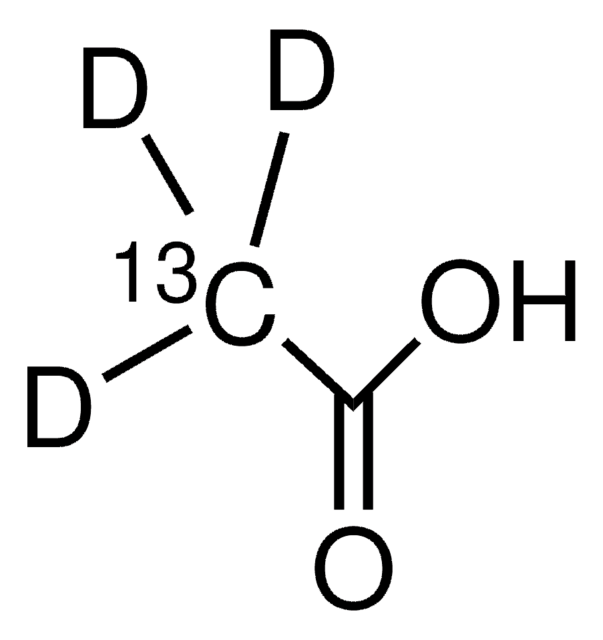151785
Acetic acid-d4
≥99.5 atom % D
Sinónimos:
Acetic-d3 acid-d, Tetradeuteroacetic acid
About This Item
Productos recomendados
densidad de vapor
2.07 (vs air)
presión de vapor
11.4 mmHg ( 20 °C)
pureza isotópica
≥99.5 atom % D
Análisis
≥99% (CP)
formulario
liquid
temp. de autoignición
800 °F
lim. expl.
16 %
técnicas
NMR: suitable
bio NMR: suitable
impurezas
≤0.0500% water
water
índice de refracción
n20/D 1.368 (lit.)
bp
115.5 °C (lit.)
mp
15-16 °C (lit.)
densidad
1.119 g/mL at 25 °C (lit.)
cambio de masa
M+4
cadena SMILES
[2H]OC(=O)C([2H])([2H])[2H]
InChI
1S/C2H4O2/c1-2(3)4/h1H3,(H,3,4)/i1D3/hD
Clave InChI
QTBSBXVTEAMEQO-GUEYOVJQSA-N
¿Está buscando productos similares? Visita Guía de comparación de productos
Categorías relacionadas
Descripción general
Aplicación
Acetic acid-d4 may also be used as a deuterated solvent in the 1H NMR spectral studies of the following:
- CB2, a CNBr peptide
- α - tocopherol succinate hydrophobically modified chitosan(CS-TOS)
Productos recomendados
Palabra de señalización
Danger
Frases de peligro
Consejos de prudencia
Clasificaciones de peligro
Eye Dam. 1 - Flam. Liq. 3 - Skin Corr. 1A
Código de clase de almacenamiento
3 - Flammable liquids
Clase de riesgo para el agua (WGK)
WGK 1
Punto de inflamabilidad (°F)
104.0 °F - closed cup
Punto de inflamabilidad (°C)
40 °C - closed cup
Equipo de protección personal
Faceshields, Gloves, Goggles, type ABEK (EN14387) respirator filter
Certificados de análisis (COA)
Busque Certificados de análisis (COA) introduciendo el número de lote del producto. Los números de lote se encuentran en la etiqueta del producto después de las palabras «Lot» o «Batch»
¿Ya tiene este producto?
Encuentre la documentación para los productos que ha comprado recientemente en la Biblioteca de documentos.
Los clientes también vieron
Artículos
Use this reference table to find the coupling values and chemical shifts of our NMR (deuterated) solvents. Melting and boiling points, molecular weight, density, and CAS number are also listed.
Nuestro equipo de científicos tiene experiencia en todas las áreas de investigación: Ciencias de la vida, Ciencia de los materiales, Síntesis química, Cromatografía, Analítica y muchas otras.
Póngase en contacto con el Servicio técnico













